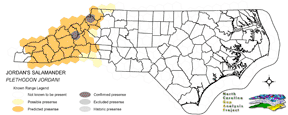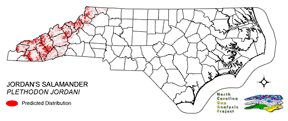
| Taxa: |
| Order: |
| Family: |
| Amphibia |
| Caudata |
| Plethodontidae |
| NatureServe Global Rank: |
| NatureServe State (NC) Rank: |
| G5 |
| S5 |
| Federal Status: |
| NC State Status: |
| --- |
| --- |


| Land Unit |
| US Fish & Wildlife Service |
| US Forest Service |
| US National Park Service |
| US Department of Defense |
| NC State Parks |
| NC University System |
| NC Wildlife Res. Com. |
| NC Forest Service |
| NC Div. of Coastal Mgmt. |
| Local Governments |
| Non-Governmental Org. |
| Other Public Lands |
| Private Lands |
| GAP Status 1-2 |
| All Protected Lands |
| Statewide |
| Hectares |
| 0.00 |
| 154,513.17 |
| 0.00 |
| 59,289.21 |
| 918.90 |
| 53.19 |
| 2,303.46 |
| 690.81 |
| 0.00 |
| 4,413.33 |
| 3,971.79 |
| 8.28 |
| 279,086.22 |
| 83,425.38 |
| 226,032.63 |
| 505,248.36 |
| Acres |
| 0.00 |
| 381,810.28 |
| 0.00 |
| 146,506.80 |
| 2,270.65 |
| 131.44 |
| 5,691.97 |
| 2,615.59 |
| 0.00 |
| 10,905.57 |
| 9,814.50 |
| 20.46 |
| 689,636.93 |
| 207,057.12 |
| 559,447.24 |
| 1,249,404.20 |
| % of Dist. on |
| Prot. Lands |
| 0.0 % |
| 68.4 % |
| 0.0 % |
| 26.2 % |
| 0.4 % |
| < 0.1 % |
| 1.0 % |
| 0.3 % |
| 0.0 % |
| 1.7 % |
| 1.7 % |
| < 0.1 % |
| 0.0 % |
| 36.9 % |
| ----- |
| ----- |
| % of Dist. on |
| All Lands |
| 0.0 % |
| 30.6 % |
| 0.0 % |
| 11.7 % |
| 0.2 % |
| < 0.1 % |
| 0.5 % |
| 0.1 % |
| 0.0 % |
| 0.9 % |
| 0.8 % |
| < 0.1 % |
| 55.2 % |
| 16.5 % |
| ----- |
| ----- |
|
Populations of this species occupy most of the North Carolina mountains and some isolated upper piedmont localities (Martof et al. 1980). Populations near and into Georgia and South Carolina may be restricted to deep moist gorges and high annual precipitation belts (Petranka 1998). Shaded rock outcrops in mesic to regularly saturated soil situations are used (Wilson 1995). Forest associates include but are not limited to mixed pine-hardwoods, white pine-hemlock, and white oak-red oak-black oak. NATURE SERVE GLOBAL HABITAT COMMENTS: Moist dense forest (hardwood, coniferous, or mixed) with mossy logs and slabs of rock. Occupies burrows, leaf litter, or spaces under rocks and logs during day. Eggs are laid probably in underground cavities. |
| Code | Name | Description | NC Natural Heritage Program Equivalent |
| 230 | Piedmont Mesic Forest | American Beech - Red Oak - White Oak Forests. | Mesic Mixed Hardwood |
| 384 | Piedmont/Mountain Mixed Bottomland Hardwood Forests | Includes temporarily to seasonally forests dominated by hardwood species. Hardwoods include sweetgum, red maple, sycamore which co-occur in a mosaic of bottomland and levee positions. Includes alluvial hardwood forests in the mountains. Hemlock and white pine may occur as inclusions, but are generally mapped separately. | Piedmont/Mountain Alluvial Forest, Piedmont/Mountain Levee Forest |
| 383 | Piedmont Mixed Successional Forest | Generally loblolly mixed with successional hardwoods. Sweetgum, tulip poplar and red maple are common co-dominants in these successional forests. | No equivalent |
| 517 | Hemlock Floodplain Forest | Alluvial forest with hemlock and/or white pine in mountains and western piedmont. Hydrology is generally temporarily to seasonally flooded. | Canada Hemlock Forest |
| 522 | Northern Hardwoods | High Elevation forests including yellow birch, American beech, and yellow buckeye. Includes forests with Hemlock and Yellow Birch. | Northern Hardwoods Forest, Boulderfield Forest |
| 525 | Appalachian Oak Forest | A variety of oak forest types including Black, White, Scarlet Oaks in dry to mesic situations. Includes forests historically co-dominated by American Chestnut. | High Elevation Red Oak Forest, Montane White Oak Forest |
| 526 | Appalachian Cove Forest | Mixed Mesophytic forests of the mountains. Includes tuliptree, basswood, yellow buckeye and surgar maple. This class is mapped to include cove forests dominated or co-dominated by hemlock. | Rich Cove Forest, Acidic Cove Forest |
| 527 | Appalachian Hemlock | Upland hemlock forests of the moutains region. Vary from side slopes to steep slope positions. | Canada Hemlock Forest |
|
Nishikawa, K. C. 1990. Intraspecific spatial relationships of two species of terrestrial salamanders. Copeia 1990:418-426.
Hairston, N. G., Sr., and R. H. Wiley. 1993. No decline in salamander (Amphibia:Caudata) populations:a twenty-year study in the southern Aplachians. Brimleyana 18:59-64. Petranka, J. W., M. E. Eldridge, and K. E. Haley. 1993. Effects of timber harvesting on southern Appalachian salamanders. Conservation Biology 7(2):363-370. Hairston, N. G., Sr., et al. 1992. The dynamics of two hybrid zones in Appalachian salamanders of the genus PLETHODON. Evolution 46:930-938. Wilson, L. A. 1995. The Land Manager's Guide to the amphibians and reptiles of the South. Chapel Hill, NC: The Nature Conservancy. Petranka, J. W. 1998. Salamanders of the United States and Canada. Washington DC: Smithsonian Inst. Press. Hairston, N. G. 1983. Growth, survival and reproduction of PLETHODON JORDANI:trade-offs between selective pressures. Copeia 1983:1024-1035. Highton, R. 1983. A new species of woodland salamanders ofthe PLETHODON GLUTINOSUS group from the southern Appalachian Mountains. Brimleyana 9:1-20. Behler, J. L., and F. W. King. 1979. The Audubon Society field guide to North American reptiles and amphibians. Alfred A. Knopf, New York. 719 pp. Martof, B. S., W. M. Palmer, J. R. Bailey, and J. R. Harrison, III. 1980. Amphibians and reptiles of the Carolinas and Virginia. University of North Carolina Press, Chapel Hill, North Carolina. 264 pp. Mitchell, J. C., and J. A. Taylor. 1986. Predator-prey size relationships in a North Carolina population of PLETHODON JORDANI. J. Herpetol. 20:562-566. Dawson, W. R., et al. 1987. Report of the Scientific Advisory Panel on the spotted owl. Condor 89:205-229. Highton, R. 1973. PLETHODON JORDANI. Cat. Amer. Amphib. Rept. 130.1-130.4. |
For more information please contact them at:
NC-GAP Analysis Project
Dept. of Zoology, NCSU
Campus Box 7617
Raleigh, NC 27695-7617
(919) 513-2853
www.basic.ncsu.edu/ncgap